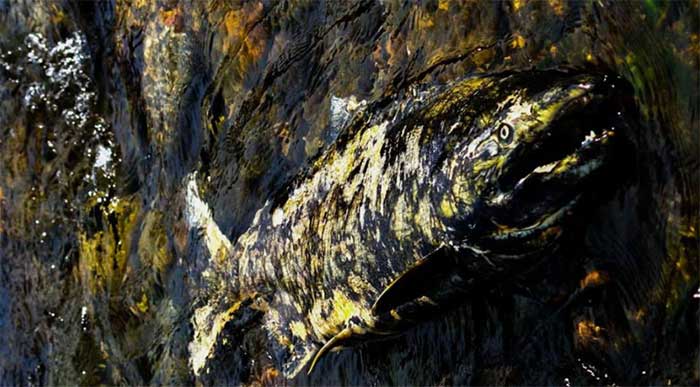Detect 3 mysterious viruses that have not been detected in Pacific salmon species
Genetic analysis of the endangered Pacific salmon population has identified three previously unknown viruses. One of them belongs to an unknown virus group that causes disease in fish.
Chinook salmon and sockeye in the cold waters of the US and the Pacific Northwest of Canada are considered key species, playing a pivotal role in supporting the ecosystems in which they live. Nutrients between the two types are the main source of food for predators in the area.

A salmon died of a virus.
The researchers say they are not sure how salmon will be affected, but the viruses are known to cause serious illness in other species. Fortunately, it does not pose any risks to humans.
DNA was first sequenced from more than 6,000 dead salmon including wild fish and hatcheries. The scientists then used specific tests for each virus to screen.
They found evidence of a new arenavirus, reovirus and nidovirus . Two of them are present in all three sources while the third is found only in farmed fish.
Viral researcher Curtis Scos said: "We have found new viruses widely distributed in dead salmon. The software emphasizes the potential role of the virus to play an important role. to the population of wild fish stocks and the threat these viruses may pose to aquaculture. '
Over the past three decades, there has been a decline in the chinook and sockeye populations, which is important for traders and indigenous communities that rely on salmon. It is unclear why salmon populations are declining but the study authors noted that infectious diseases may play an important role.
- Will hydroelectric dams eradicate the largest Pacific salmon?
- The ancestors of salmon have sharp teeth 20cm long
- Salmon and mysterious breeding mechanism against
- Russia implemented a salmon protection project for future generations
- Severe drought, the US carries 30 million salmon to the sea
- Video: Giant salmon stalking rats
- Mysterious long crab species by car in the Pacific Ocean
- Spectacular migration of red salmon in Canada
- Mysterious red orange glow on the Pacific Ocean
- This is why you should stop eating farmed salmon
- Can catch giant salmon, like monsters in America
- Natural mystery: migrate a record 8 million salmon
 Why do potatoes have eyes?
Why do potatoes have eyes? 'Tragedy' the world's largest carnivorous life: Death becomes ... public toilet
'Tragedy' the world's largest carnivorous life: Death becomes ... public toilet Tomatoes were once considered 'poisonous' for 200 years
Tomatoes were once considered 'poisonous' for 200 years Detecting microscopic parasites on human face
Detecting microscopic parasites on human face Killer whales carrying dead salmon leave scientists baffled
Killer whales carrying dead salmon leave scientists baffled  The largest salmon on Earth has tusks like a humped pig
The largest salmon on Earth has tusks like a humped pig  What happened to the salmon during their journey in the mysterious 'black box'?
What happened to the salmon during their journey in the mysterious 'black box'?  Launch of the first artificial salmon meat from plants
Launch of the first artificial salmon meat from plants  The river is dyed red by tens of millions of creatures migrating from the sea, what is this creature?
The river is dyed red by tens of millions of creatures migrating from the sea, what is this creature?  Make a plastic cup from salmon sperm
Make a plastic cup from salmon sperm 